Belper, Derbyshire
Up to 1834
A Parliamentary report of 1777 recorded the existence of parish workhouses in Crich (with accommodation for up to 40 inmates), Duffield (20), and Wirksworth (60).
Crich's workhouse was erected by the parish authorities in 1734. It was on Workhouse Row, on the edge of the Nether Common. Paupers were sent to the Crich workhouse by several other parishes in the area including Denby, Melbourne, Mercaston, Pentrich, and Willington.
Belper had a parish workhouse in the stepped terraces on the northern side of Belper Lane and could accommodate around 28 paupers.
In Alfreton, a poorhouse was erected just outside the town. In 1804, the parish is said to have adopted Gilbert's Act.
Wirksworth's workhouse was in operation from 1724 until 1829 and for at least some of that time occupied Babington House on Green Hill. The workhouse was the subject of a report by Eden, in his 1797 survey of the poor in England:
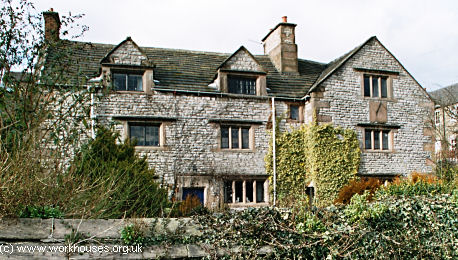
Wirksworth former parish workhouse, 2005.
© Peter Higginbotham.
After 1834
Belper Poor Law Union formally came into existence on 5th May 1837. Its operation was overseen by an elected Board of Guardians, 47 in number, representing its 32 constituent parishes as listed below (figures in brackets indicate numbers of Guardians if more than one):
Derbyshire:
Alderwasley, Allestree, Ashley Hay, Belper (6), Crich (2), Denby (2), Dethwick Lea and Holloway, Duffield (2), Hazlewood, Headge (2), Holbrooke, Horseley, Horseley Woodhouse, Ideridgehay and Alton, Ireton Wood, Kedlaston, Kilburn, Kirk Langley and Meynell Langley, Mackworth, Mapperley Markeaton, Morley, Pentrich, Quorndon, Ripley (2), Shuttle and Postern, Smalley, South Wingfield (2), Turnditch, Weston Underwood (2), Windley, Wirksworth (4).
The parishes of Alfreton, Mugginton and Ravensdale park were added on 30th September, 1837.
Later Additions: Milford (1897), Rowditch (1890).
The population falling within the Union at the 1831 census had been 33,388 — ranging from Kedlaston (population 134) to Belper itself (7,890).
The new Board of Guardians held its inaugural meeting in May 1837 at the Lion Inn, Bridge Street. The priority of erecting new workhouse was agreed upon, with the capacity of the three existing parish workhouses in the Union being inadequate. A report in November 1837 by one of the Union's medical officers highlighted the poor state of medical provision at the time. One of the sick poor, "aged 78, has lain upon a squab in a stockinger's room for the last four months — he was supposed to have had a paralytic stroke, but his case has turned out to be a fracture of the neck of the thigh bone."
The architects appointed to design the workhouse were the prolific partnership of George Gilbert Scott and William Bonython Moffatt who were also responsible for the workhouse at Chesterfield. Because of changes in the site, and in the architects' design, there were several delays in starting construction. There were also problems during the building work, including the bankruptcy of the building contractors. The building was eventually completed in September 1840 on a 2.5 acre site at Babington Meadow which had been purchased for £750 from local landowner George Benson Strutt. The building was constructed from local Derbyshire stone at a cost of £8,700 and was intended to accommodate up to 300 inmates. The location and layout of the workhouse can be seen on the 1913 map below.
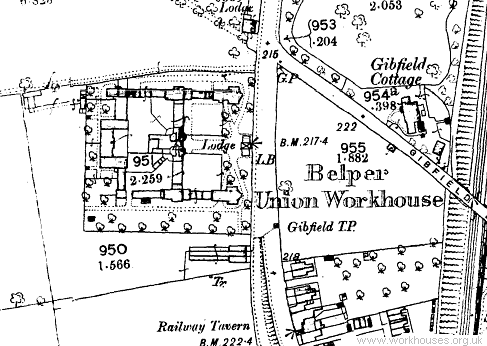
Belper workhouse site, 1881.
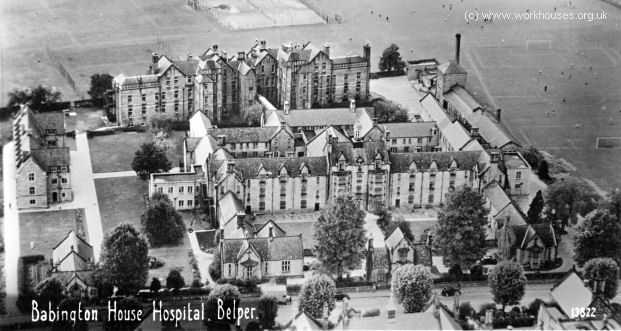
Belper aerial view from the south.
© Peter Higginbotham.
At the east of the site, facing onto the Derby Road, was the main entrance lodge with a central archway leading through to the workhouse.
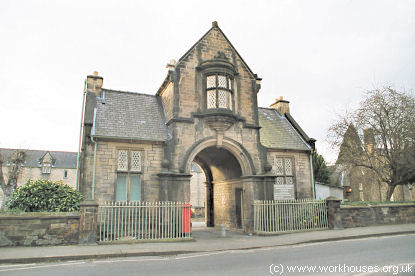
Belper entrance lodge from the east, 2005.
© Peter Higginbotham.
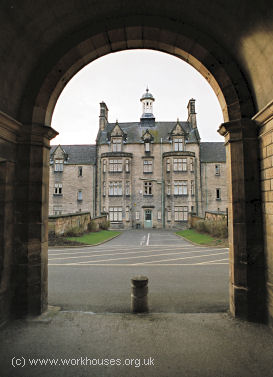
Belper archway lodge from the east, 2005.
© Peter Higginbotham.
A smaller lodge was located at the north-east corner of the site. This was later used as a cobbler's workshop where the inmates could get their shoes repaired.
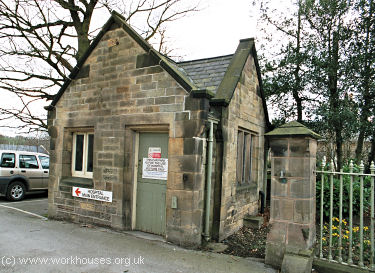
Belper entrance lodge from the east, 2005.
© Peter Higginbotham.
A walled path from led from the entrance to the main accommodation block. The walled-off areas to each side formed exercise yards for different classes of inmates. The centre of the main block was four storeys high with three-storey wings to each side, and two-storey cross-wings at each end.
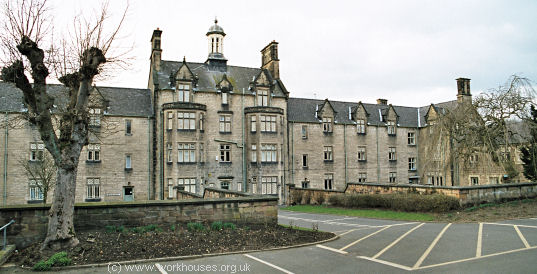
Belper main block from the east, 2001.
© Peter Higginbotham.
At the centre rear of the main block was a single storeyed block which probably served as a dining hall and chapel.
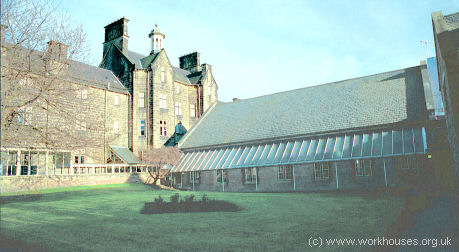
Belper dining hall from the north, 2001.
© Peter Higginbotham.
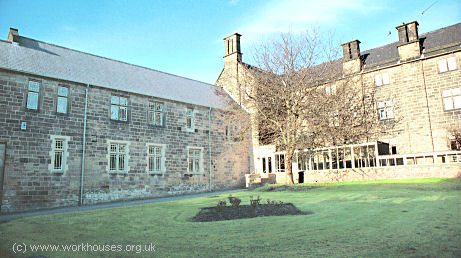
Belper north-west courtyard from the south-east, 2001.
© Peter Higginbotham.
A long single-storey laundry block ran along the northern edge of the site.
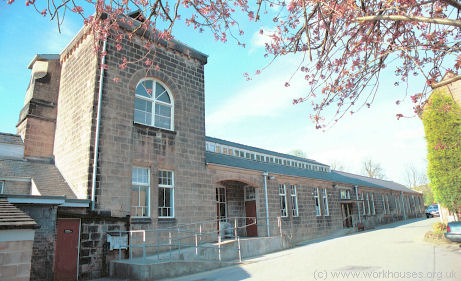
Belper northern block from the south-west.
© Peter Higginbotham.
In 1889, a large new infirmary was erected at the west of the site.
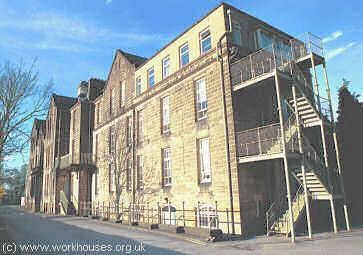
Belper 1889 infirmary from the south-west, 2001.
© Peter Higginbotham.
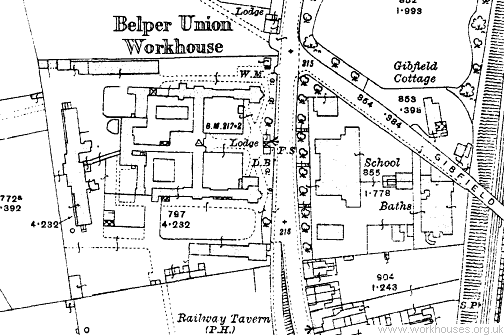
Belper workhouse site, 1913.
The photo below show the infirmary's No. 2 women's ward decorated for Christmas in 1911.
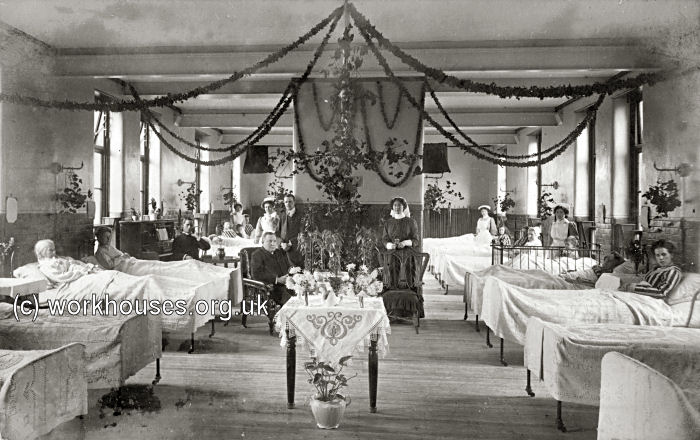
Belper workhouse infirmary, 1911.
© Peter Higginbotham.
Some time after 1913, a further block was added at the south-west of the site.
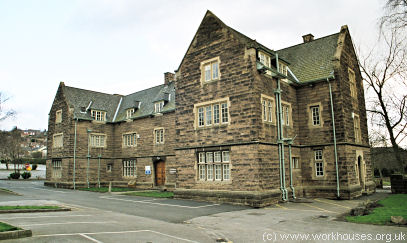
Belper south-west block from the north-west, 2005.
© Peter Higginbotham.
The workhouse inmates provided much of the labour to run the establishment and minimise running costs. Soon after it opened, the weekly provisions bill was around £17 for the 158 inmates. Boy inmates were taught shoemaking and tailoring. Vagrants were accommodated in tramp cells and had to pay for their night's accommodation by breaking stone into pieces small enough to pass through a metal grille. The tramp cells were demolished in 1954 and the stone-breaking grilles donated to Derby Museum.
After 1930, control of the site passed to Derbyshire County Council and was became Babington House Public Assistance Institution. Between 1930 and 1941, the council undertook an extensive modernisation scheme. During the Second World War, the hospital participated in the Emergency Medical Services scheme. Following the inauguration of the National Health Service in 1948, the institution was renamed Babington Hospital providing care for 155 geriatric and 16 maternity patients.
In 204, the site was put up for sale, with plans to convert the building into 70 flats, with the existing medical facilities being transferred to new accommodation on the Belper Clinic site, also on Derby Road.
Cottage Homes
The Belper Union established children's a cottage home for 30 girls at 50-52 Holbrook Road, Belper, A home for 15 boys was opened at Park Side, Belper.
Staff
Inmates
Records
Note: many repositories impose a closure period of up to 100 years for records identifying individuals. Before travelling a long distance, always check that the records you want to consult will be available.
- Derbyshire Record Office, New Street, Matlock, Derbyshire. Holdings include: Guardians' minute books (1837-1930); Admissions and discharges (1840-50, 1853-1911); Births (1840-1957); Deaths (1840-1914); Creed registers (1869-93); etc.
Bibliography
Links
- None.
Unless otherwise indicated, this page () is copyright Peter Higginbotham. Contents may not be reproduced without permission.


